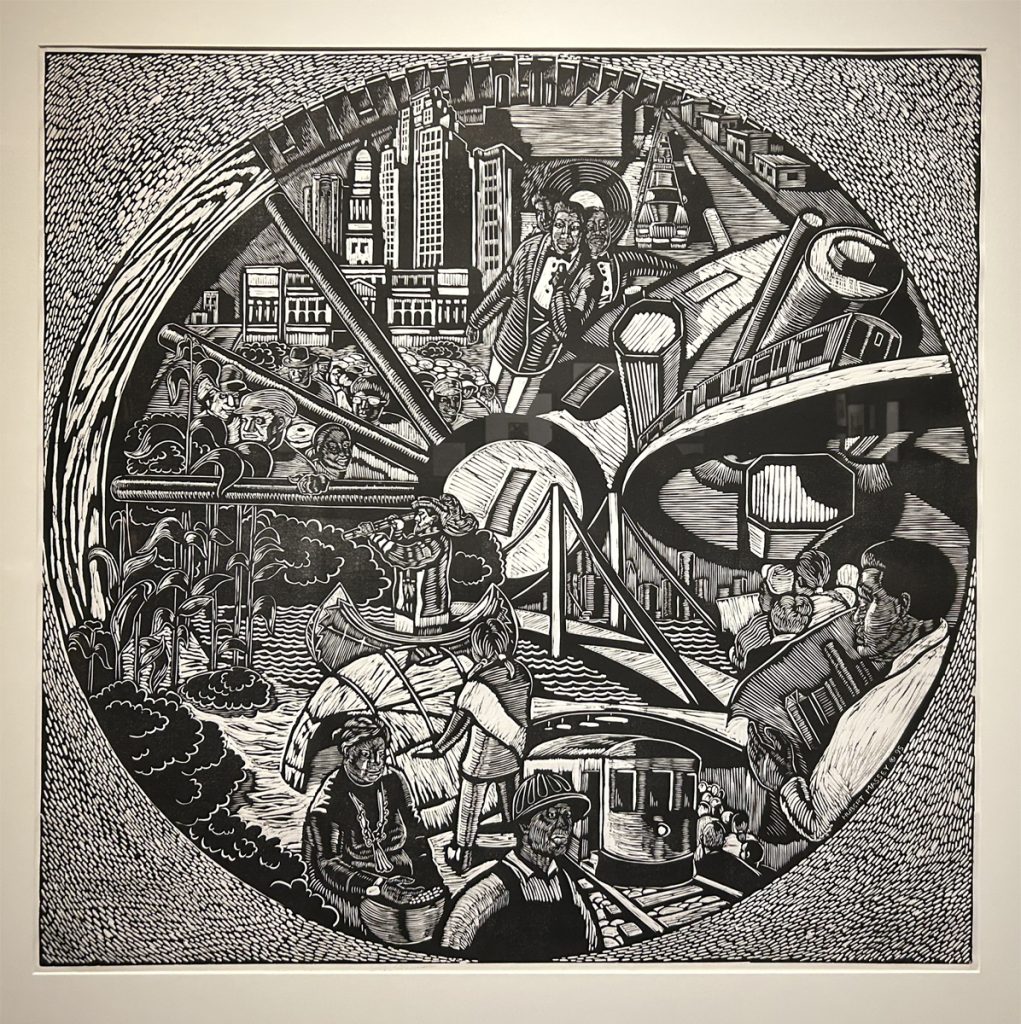
 Hubert Massey, “History of Detroit,” 1995, linocut/Photo: Flint Institute of Arts, Michigan
Hubert Massey, “History of Detroit,” 1995, linocut/Photo: Flint Institute of Arts, MichiganMuseums, with their culturally significant objects and impressive supporting scholarship, often present us with a comforting illusion of stability, even permanence. But “In Their Own Backyard,” an exhibition now at the Flint Institute of Arts (FIA), tells a different story. It is, perhaps, even a cautionary tale in pictures, of creation and destruction and of time’s toll on everything that humans create.
This relatively small exhibition consists of works on paper drawn from the museum’s permanent graphics collection. The watercolors, prints and drawings of local scenes by local artists, are mostly of local interest, though curators Cindy Parsell and Emily Legleitner have done an exemplary job of adding historical context with extensive wall labels and accompanying photographs. Of the twenty-one artworks in the exhibition, twelve depict scenes from the Flint area. Other locales, such as Marquette, Mackinac Island, Detroit and Ann Arbor, are also represented in artworks that range in quality from mediocre to workmanlike to accomplished. However, the formal qualities of the paintings, prints and drawings are less important than their function as records, or even memorials, to landscapes and buildings that now exist only in memory.

 Emil Weddige, “State Street,” 1964-1966, color lithograph/Photo: Flint Institute of Arts, Michigan
Emil Weddige, “State Street,” 1964-1966, color lithograph/Photo: Flint Institute of Arts, MichiganIn addition to a straightforward record of changes in Michigan’s landscape and architecture through visual art, “In Their Own Backyard” contains an art historical subplot describing advances in print technologies of the late twentieth century. Master lithographer Emil Weddige was a pioneer in the medium of color lithography and helped to popularize it from his position as a professor at the University of Michigan College of Architecture and Design, where he taught from 1939 until his death in 2001. Two of his lithographs of Ann Arbor scenes are in the exhibition. Weddige was influential among a group of Michigan printmakers that also included William R. Stolpin, Carole Perkins Brender and James H. Anthony, all of whom are also represented in this show.
Hubert Massey, born in Flint in 1958, is one of the few artists in the exhibition with whom I was already familiar. A prolific muralist now living in Detroit, the African American regionalist is best known for his mastery of the Renaissance technique of fresco. The linocut on display here, “History of Detroit,” is a large tondo featuring his characteristic combination of muscular figures and industrial architecture. Massey recently completed a fresco in Detroit’s Cobo Center (Huntington Place) as well as murals at the Charles H. Wright Museum of African American History and at the Flint Institute of Arts.

 Jack Keijo Steele, “Study for Recess at St. Boniface,” ca. 1946, gouache/Photo: Flint Institute of Arts, Michigan
Jack Keijo Steele, “Study for Recess at St. Boniface,” ca. 1946, gouache/Photo: Flint Institute of Arts, MichiganA small 1946 gouache, “Study for Recess at St. Boniface,” by Jack Keijo Steele, is all that remains of St. Boniface Catholic Church in Detroit. In the 1860s, the (formerly Irish) Corktown neighborhood saw growing waves of German immigrants, which prompted the creation of St. Boniface parish and the construction of a handsome, stone Romanesque Revival church. Architectural merit and historical significance couldn’t save the one hundred-year-old St. Boniface, though. Despite its designation as a Michigan State Historic Site in 1983, the church was demolished in 1996 to make room for a parking lot.
The pictures on display from the FIA’s graphics collection tell an important story of the Rust Belt’s rise and fall—and rise—in bricks and mortar. They remind us that no matter how solid any given edifice or landscape may seem, none is immune from the invisible forces of physical decay, social decline and political pressure.
“In Their Own Backyard: Michigan Artists and Architecture” is on view at the Flint Institute of Arts, 1120 East Kearsley Street, Flint, Michigan, through May 18.
